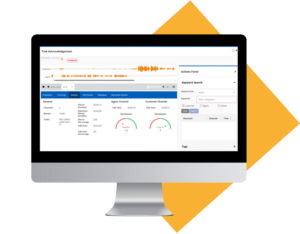Imagine a world where every customer interaction is handled with precision, where every call, chat, or email leads to a satisfying conclusion. This is not a far-fetched future; it’s the reality unfolding in the contact centre industry, driven by the relentless pursuit of workforce optimisation. The past year has been a revelation in this sector, showcasing statistics that underscore the pivotal role of effective workforce management in boosting customer experience and operational efficiency.
Consider the digital revolution in customer engagement: Since 2020, a staggering 57% of customers have shifted their preference to digital channels for interacting with companies. This seismic shift has catapulted cloud-based contact centre solutions into the spotlight, with about 75% of centres now thriving in the cloud, reaping the benefits of heightened employee engagement and satisfaction.
Speed is of the essence in today’s customer service landscape. A whopping 90% of customers demand instant responses from customer service, setting a new standard for rapid assistance. Mobile customer service has become a norm, with 79% of customers reaching out via their mobile devices in the past six months, underscoring the need for optimised service channels that cater to this mobile-first world.
The transformative role of AI in contact centres is undeniable. About 85% of customer experience (CX) professionals recognise the critical importance of integrating AI into customer service. This integration isn’t just about improving satisfaction; it’s a cost-effective strategy, potentially saving up to $80 billion in staffing costs by 2026. Yet, despite these technological leaps, the human touch remains indispensable. A considerable 34% of agents report a lack of access to crucial customer data, and 68% of customers still find a pleasant representative key to a positive service experience.
Empowering Teams with AI-Powered Tools
Cirrus leverages AI to elevate team performance in contact centres. AI-powered tools automate routine tasks, provide real-time insights, and enable better decision-making. These tools help streamline operations, reduce human error, and enhance efficiency. For instance, AI can analyse customer interactions to identify trends and patterns, which aids in optimising customer service strategies.
AI also plays a crucial role in predictive analytics, forecasting call volumes and customer inquiries, allowing for better staff allocation and resource management. This foresight helps prepare the team for peak times, ensuring customer demands are promptly and efficiently met.
Examples of AI-powered solutions used by Cirrus
- Chatbots and Virtual Assistants: Cirrus integrates AI-driven chatbots and virtual assistants to handle basic customer queries. This technology speeds up response times and allows human agents to focus on more complex issues, thereby increasing overall productivity and customer satisfaction.
- Intelligent Call Routing: Utilising AI for intelligent call routing ensures that customers are directed to the most suitable agent based on their query and the agent’s expertise. This improves the customer experience and maximises the agents’ potential.
- Quality Analytics and Sentiment Analysis: AI tools in Cirrus analyse customer calls for speech patterns and sentiments. This analysis helps understand customer emotions and feedback, leading to more personalised service and improved customer engagement strategies.
Enhancing Customer Experience Through Unified Interface
Cirrus offers a unified interface consolidating various customer service channels into a single platform. This interface includes channels like voice, email, chat, and social media, providing a holistic view of customer interactions. The unified interface simplifies management, allowing agents to access all necessary information in one place, leading to more efficient and effective customer service.
This approach ensures consistency in service delivery across different channels and allows for seamless transitions between them. For example, an issue initiated via chat can be smoothly escalated to a phone call without losing context.
How this interface improves customer service across various channels:
- Enhanced Customer Interaction Tracking: The unified interface tracks customer interactions across all channels, providing agents with a comprehensive view of the customer’s history. This leads to more informed and personalised interactions, as agents are well-equipped with the context of previous engagements.
- Improved Response Times: With all communication channels integrated into one interface, agents can respond more quickly to customer queries, irrespective of the channel used. This responsiveness is crucial in enhancing customer satisfaction and loyalty.
- Consistency in Service Delivery: The unified platform ensures that the quality of service is consistent across all channels. Whether a customer reaches out via email, social media, or phone, they receive the same level of service, which is vital for building trust and a positive brand image.
Data-Driven Decision-Making
In contact centre operations, data-driven decision-making plays a crucial role. Real-time data is instrumental in making informed decisions that significantly impact customer service delivery and operational efficiency. Real-time data analytics provide a live snapshot of customer interactions, agent performance, and overall contact centre health.
This immediate insight allows managers to make on-the-spot adjustments to strategies, such as reallocating resources during unexpected spikes in call volumes or addressing emerging customer service trends. Real-time data ensures that decision-making is proactive rather than reactive, allowing for a more dynamic and responsive contact centre environment.
Benefits of AI-driven insights in contact centre operations
- Enhanced Customer Understanding: AI-driven insights help understand customer preferences, behaviours, and needs through pattern recognition and predictive analytics. This understanding allows for more tailored customer service strategies.
- Optimised Resource Allocation: By predicting call volumes and customer inquiry types, AI-driven data analytics enable better staffing and resource allocation. This optimisation ensures the contact centre is well-equipped to handle peak times efficiently.
- Improved Service Quality: Continuous monitoring and analysis of data lead to a better understanding of which practices are most effective, allowing for continuous improvement in service quality.
 Automated Scoring, Feedback, and Training
Automated Scoring, Feedback, and Training
Automated scoring and feedback systems in contact centres are critical for maintaining high service standards. These systems use AI and machine learning algorithms to evaluate customer-agent interactions. Key performance indicators like call handling time, resolution rate, and customer satisfaction scores are automatically analysed for a comprehensive performance review.
This automated approach ensures a consistent and objective evaluation process. It also provides agents with immediate feedback, essential for their professional development. By identifying areas for improvement, agents can focus on specific skills or knowledge areas.
Impact on agent performance and overall service quality
- Enhanced Agent Skill Development: Automated training systems provide personalised learning pathways for agents, allowing them to develop the skills most relevant to their needs. This targeted training approach leads to a more skilled and efficient workforce.
- Continuous Performance Improvement: Regular feedback and scoring keep agents informed about their performance, encouraging continuous improvement and helping them to adapt to changing customer service standards.
- Consistency in Customer Service: With a standardised system for scoring and training, there is a higher likelihood of maintaining a consistent level of service across the contact centre, regardless of individual agent differences.
Advanced Features for Workforce Management
Advanced workforce management in contact centres involves several key features, each playing a critical role in optimising operations:
- Intelligent Forecasting: This involves using historical data and AI algorithms to predict future call volumes and customer interaction trends. Intelligent forecasting helps anticipate busy periods and prepare accordingly, ensuring that staffing levels are adequate to handle the projected workload.
- Dynamic Scheduling: Linked with forecasting, dynamic scheduling adjusts staff schedules in real-time based on actual and predicted demand. This flexibility ensures that the contact centre is always staffed, which can lead to reduced costs and improved agent morale.
- Advanced Analytics: This encompasses the analysis of various data points such as call duration, resolution rates, customer feedback, and agent performance metrics. These analytics provide deep insights into operational efficiency and areas for improvement, guiding strategic decisions.
The importance of these features in optimising staffing and resources
- Resource Optimisation: Intelligent forecasting and dynamic agent scheduling ensure that resources are utilised efficiently, reducing instances of overstaffing or understaffing.
- Cost Efficiency: By aligning staffing needs with actual demand, these features help minimise unnecessary labour costs.
- Enhanced Customer Satisfaction: Proper staffing directly impacts response times and service quality, which are crucial for customer satisfaction.
- Agent Satisfaction and Retention: Balanced workloads and schedules contribute to better job satisfaction among agents, which can lead to lower turnover rates.
 Quality Monitoring and Continuous Improvement
Quality Monitoring and Continuous Improvement
Contact centres must focus on quality monitoring and continuous improvement to maintain high customer service standards. This involves several strategies:
- Regular Monitoring and Evaluation: Continuous monitoring of customer interactions and agent performance. This involves assessing call recordings, customer feedback, and other performance metrics to ensure that quality standards are met.
- Feedback Loop: Implement a feedback loop where agents receive regular, constructive feedback based on performance metrics. This helps in identifying areas for improvement and personal development.
- Adaptation and Evolution: Adapting strategies and processes based on evolving customer needs and feedback, ensuring that the service remains relevant and effective.
Examples of quality management practices in place
- Agent Training Programs: Regular training sessions based on identified gaps in service quality help agents continuously improve their skills.
- Customer Satisfaction Surveys: Using customer feedback to gauge the quality of service and identify areas for enhancement.
- Performance Benchmarking: Setting clear performance benchmarks and using analytics to track agent performance against these standards.
- Root Cause Analysis: When issues are identified, thorough analyses to understand underlying causes and implement solutions to prevent recurrence.
Conclusion
Recap of key points discussed
- AI-Powered Tools: Using AI in workforce optimisation enhances team performance and customer service efficiency.
- Unified Interface: A unified platform for managing customer interactions improves service consistency and response times.
- Data-Driven Decision Making: Real-time data and AI-driven insights are crucial in making informed operational decisions.
- Automated Scoring and Training: Automated agent evaluation and training systems contribute to consistent service quality and agent skill development.
- Advanced Workforce Management Features: Intelligent forecasting, scheduling, and analytics are key to optimising staffing and resources.
- Quality Management: Continuous quality management and improvement ensure high service standards and adaptability to changing customer needs.
Final thoughts on the future of workforce optimisation in contact centres…
The future of workforce optimisation in contact centres looks increasingly digital and data-driven. With advancements in AI and machine learning, there is a clear trend towards more automated, efficient, and customer-centric operations. Integrating these technologies not only promises enhanced customer experiences but also significantly improves operational efficiency and employee satisfaction. As customer expectations continue to evolve, the ability of contact centres to adapt and leverage these technological advancements will be crucial in maintaining a competitive edge.
If you are considering investing in a workforce optimisation solution for your contact centre, contact Cirrus for a free consultation today.
Download our WFO brochure Contact us




